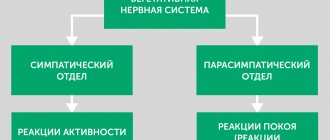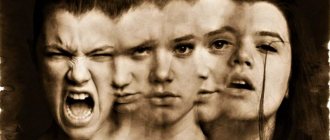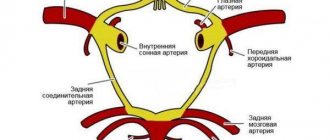Causes of depression
The main reason that leads to depression is an incorrect interpretation of an unpleasant event. Why is this happening? Here a more subtle differentiation of factors occurs. Depression can be caused by pessimism, lack of resistance to stress, lack of relaxation skills, inadequate coping strategies (for example, if a person runs to a liquor store in a stressful situation), destruction of the protective mechanisms of the psyche, and negative experiences of depression in the past.
As a result of an incorrect interpretation of an unpleasant event, so-called irrational cognitive formations arise, in other words, complexes. These are attitudes such as: “Nobody loves me”, “I am a loser”, “It is impossible to achieve success in our country” and others. They are generated by the fact that a person focuses attention only on the negative. In general, the main cause of depression lies in a person’s personal qualities.
Symptoms of depression
Symptoms of depression vary in their semantic characteristics, intensity of expression, and duration of impact. Many manifestations of the disorder are masked, and their negative impact is not recognized by the person. Other signs of the disorder, such as pessimism, despondency, loss of vitality, are often considered by a person as a consequence of fatigue, and, accordingly, do not attach much importance to their existence. Or the person attributes such phenomena to his own laziness and begins to engage in self-accusation. The third symptoms are very similar to signs of somatic diseases, which is why they are interpreted by people as signals of physical illness.
How does hypnosis work?
Hypnosis affects several of these causes simultaneously, and at a very deep level. During therapy, the hypnologist gains access to the person's unconscious, which allows him to study his specific case. Hypnosis also helps a person relax, which allows him to instill positive beliefs and constructive programs for responding to stress.
In a state of hypnotic trance, the cognitive barrier is bypassed, and therefore positive attitudes become part of the personality much more easily. Hypnotherapists often say that the results are permanent, but in reality this is not always the case. Without deep elaboration of useful beliefs, the effect will only be short-term. Therefore, hypnosis must be supplemented with other methods, which will be described further.
Hypnosis can also treat various forms of neuroses: neurasthenia, psychoneurosis and other disorders.
Tactics and techniques for inducing trance
Often audio hypnosis for depression is used if previously conducted standard psychotherapy has not yielded positive results. Hypnotherapy is also prescribed for the following treatment complications:
- The patient resists therapy, which can occur either consciously or unconsciously.
- The root cause of the disorder cannot be diagnosed.
If the patient is aware of the negative impact of depression, this will speed up the effects of hypnosis. If there is personal resistance, then recovery can be somewhat complicated.
Treatment of depression with hypnosis is based on the patient's condition. If he has developed neurotic conditions, then it is advisable to conduct additional psychotherapy, which will reduce the general manifestations of depression.
Stages of hypnotherapy
The hypnotized person is brought out of trance by the doctor’s command.
Treatment of depression with hypnosis is carried out gradually. The classic version of hypnosis involves the following stages:
- The patient is immersed in a trance.
- During the trance process, certain attitudes are suggested, which are developed on the basis of deviations identified in the patient.
- The patient is brought out of trance.
Any violation of the stages of hypnosis is prohibited! A specially designed scheme allows you to safely put a person into a state of semi-sleep, and then quickly bring him out of the trance.
If a depressive state is accompanied by the development of anxiety or aggression, then immediately before the session the hypnologist must reassure the patient. Sometimes this requires several sessions with a psychologist or resort to a special relaxation technique.
The patient is brought out of trance by the appropriate medical command, and therefore he must have complete trust in the specialist.
When putting a patient into a trance, the hypnologist must take into account his defense mechanisms, since depression usually somewhat complicates the process of conducting a hypnotic session.
About suggestibility and self-hypnosis
Mental problems are the result of severe stress, nervous overstrain, as a result of which the patient instills in himself the wrong attitudes in life, starting to live by them. Being in deep depression, a person gradually loses the desire to get rid of the problem and gives up. He begins to get used to negative factors, and any changes cause him fear.
For hypnosis for depression to be highly effective, self-hypnosis of the individual is necessary. A person must understand why such therapy is carried out and want to get rid of negative thoughts.
The basis of hypnotherapy is suggestibility. As a rule, suggestible people have good receptivity to the beliefs of the hypnologist.
Getting into and out of trance
The pendulum is a classic way to put a person into a hypnotic state
Hypnosis involves putting the patient into a deep trance. Some people believe that this state is dangerous, and a person, while under hypnosis, completely loses control over himself. However, in reality we are talking about a state between wakefulness and sleep, when the person is not paralyzed, but, on the contrary, gets more opportunities to concentrate on a specific problem.
Therefore, the fear of immersion in a trance is absolutely groundless - during the procedure, only that part of the personality that feeds on fears and complexes is switched off.
The hypnosis technique is quite simple and involves the use of the following tools to put the patient into a trance:
- Pendulum or coin. This is a classic option that has not lost its popularity these days.
- Application of tactile techniques. They began to be actively used relatively recently, but have already proven themselves to be excellent.
To enhance the hypnotic effect, the doctor can use special speech techniques, use certain sounds, and speak in a monotonous and drawn-out manner. The peculiarity of such a trance is that the patient is fully aware of what is happening to him.
Special keywords are used to bring a person out of trance. These may vary for each session.
After the patient is brought out of the trance, he needs about half an hour to recuperate.
Is hypnosis always necessary?
Hypnosis is not always needed, it all depends on the intensity of the depression. This method shows itself well as an integral part of complex psychotherapy for the treatment of complex and advanced cases of depression. But if we are talking about mild or everyday (that is, pseudo-depression) forms, then you can get by with other methods, which are discussed in the section “Alternatives to hypnosis.”
Can depression be treated with hypnosis? Yes, but not in all cases. Hypnosis is more needed in order to normalize a person’s emotional state. But if complex therapy is not carried out, the risk of relapse is very high, since a person drives himself into depression. It takes the same amount of effort to get into extreme despair or into a state of inspiration. Only the person himself decides where he wants to come. Unfortunately, many choose the first option.
When can depression not be treated this way?
There are also some contraindications to this method of therapy:
- Psychotic conditions
In particular, we are talking about a parallel course of schizophrenia, psychoses of various origins, or depression with productive symptoms. Delusions and hallucinations or pseudohallucinations (the notorious voices in the head or another part of the body). Doctors do not use hypnosis for depression that occurs against the background of psychosis, since this guarantees a worsening of the disorder.
- Presence of current infectious diseases
The body is greatly weakened, it is not known how the intervention will affect the psyche. There may be a worsening of the pathological process, a new round of depression. In this case, hypnosis is postponed until normal health is restored.
- Epilepsy
Chronic neurological disease. Manifests itself with convulsions, seizures with loss of consciousness, and hallucinations are possible. Due to the psychopathological component, the use of hypnosis to relieve depression in this case is strictly contraindicated. An exacerbation of the disease is possible. The technique will act as a kind of trigger for the onset of violations.
- Intellectual deficit
Dementia, insufficient development of mental abilities. In particular, against the background of oligophrenia. Previously suffered an infectious lesion of the brain, stroke and other conditions. Recovery is impossible, since hypnosis is likely to provoke even more severe thinking disorders. Such patients are not subject to hypnotherapy.
- Achieving the therapeutic goal earlier
Using drugs or other types of psychotherapeutic methods. Also when going beyond the resolution of the issue of dysthymic state, when the effect is clearly higher than expected and extends to other areas. The course is stopped and they return to standard medicinal methods of correction, as well as working through the problem through classical psychotherapy.
- Recent heart disease
Emergency conditions. In this case, it is worth temporarily limiting the course. Until normalcy is restored. This is not an absolute contraindication, but it is better to adhere to it, since problems are possible.
- Loss of contact and trust
The so-called rapport. Without it, adequate suggestion is impossible, therefore all attempts to introduce certain attitudes into the subconscious are doomed to failure in advance. To understand that the moment has been missed and further therapy is impossible, the doctor must have high sensitivity and the ability to empathize. Loss of trusted contact is possible and almost inevitable during the recovery process. The doctor’s task is to regain the trust of the sufferer.
- Aggressive reactions of the patient
Like the effect of hypnosis or the course of depression itself. This doesn't play a big role. The main thing worth knowing is that changes in the emotional background in a negative direction are grounds for refusing further correction or a pause
- Side effects
They can be very different. From emotional instability to somatic reactions and exacerbation of diseases.
The list is not exhaustive. The appropriateness of hypnosis for depression is determined by a psychotherapist on site after analyzing the clinical situation.
Effects of hypnosis in treating depression
Before you consider whether hypnosis can treat depression, focus on its causes. If a person is a pessimist by nature, it is impossible to make him an optimist at once. But if hypnosis does not work on him, he can once again become convinced that nothing will help in his case.
The procedure itself is pleasant: the person lies in a comfortable position, listens to the therapist’s pleasant voice, or relaxing music, and all tension goes away. Therefore, some patients may experience hypnomania. In this procedure, the neurotic sees a panacea, which forces him in any problematic situation not to try to solve it, but to get rid of symptoms through hypnosis. Naturally, like any addiction, in the future it can plunge you into depression. But everyone is different, and therefore hypnosis can lead to hypnophobia. This state is completely opposite to hypnomania and is accompanied by a panicky fear of hypnosis. In this state, the effectiveness of treatment is close to zero, since high-quality therapy is possible only if the patient trusts the hypnotist.
Types of hypnosis for depression
At the moment, more than 10 types of hypnosis are known. However, they all work on the same principle, that is, first the patient is put into a hypnotic trance, and then suggestion occurs. The difference lies only in the approach to therapy.
To combat depression, the following types of hypnosis are most effective:
1. Classic, which is the most common. In this case, the impact on human consciousness is not hidden, but obvious. The features of this type of hypnosis are:
- suggestion is carried out in an unobtrusively stern, authoritative voice;
- quick introduction to trance;
- sudden exit from a hypnotic state;
- all actions during trance are carried out through orders, authoritative phrases and clear instructions.
Classic hypnosis for depression leads to the patient losing self-control during the session, and this is the main disadvantage of this type of influence. The fact is that if an inexperienced hypnologist works, he can harm the patient.
The main method of treatment for many addictions, such as alcoholism, drug addiction or smoking, is the use of a “key-lock”. Using clear formulations in his work, the specialist prohibits the consumption of alcohol, causing a feeling of disgust towards it. This type of hypnosis is equally effective in relieving anxiety and depression.
2. Eriksonian.
This is the exact opposite of the classic type of hypnosis. In this case, suggestion occurs smoothly and unobtrusively. In addition, the patient has a choice: to accept the specialist’s instructions or refuse them. The main goal of Ericksonian hypnosis is to allow the patient to understand his dreams, true desires, as well as other forms of the subconscious. The introduction of a person into a trance is carried out smoothly and gradually, which greatly facilitates the specialist’s task. First, the hypnologist asks the patient to take the most comfortable position possible.
Autogenic training
This can be said to be the main alternative to hypnosis. A person practicing autogenic training is able to put himself into a light trance on his own, without specialists. This method has a good effect on mild forms of depression or if the person is generally depressed. In addition, those who regularly practice autogenic training are more protected from depression. Therefore, it can be considered an effective method of prevention.
The success of autogenic training has been proven even in historical examples. The famous psychologist Viktor Frankl spent several years in Nazi concentration camps, where he not only became stronger psychologically, but also helped turn the sad situation to the benefit of many other prisoners. And he owes much of his success to autogenic training.
Reviews of the work of psychologist, hypnotherapist Gennady Ivanov
The mechanism of formation of phobias is based on the idea of the dual nature of the psyche, consisting of consciousness and subconsciousness. We will use the term “subconscious”, thereby emphasizing that this “internal knowledge” can be realized. The real problem is the irrational part of fear, which over time develops into a phobia - an inadequate reaction to the environment. The rational component of fear must remain, because this basic emotion mobilizes the body’s strength in order to survive.
Treatment of phobias comes down to a conscious search for an associative connection of a particular symptom with a traumatic event of the past. Hypnotherapy techniques erase and “demagnetize” a conditioned reflex, which in many cases acts as a hypnotic suggestion.
● Allergy treatment: review of hypnosis treatment for fruit allergies. ● Hypnosis treatment: psychotherapist's review of hypnosis sessions. ● Feedback from an “unhypnotizable” director about hypnosis sessions (social phobic behavior). ● Treatment of stuttering: review of hypnosis treatment for stuttering after 4 months. ● Hypnosis: a nurse's review of the treatment of claustrophobia, fear of tunnels, elevators. ● Hypnosis: a lawyer's review of the treatment of increased anxiety. ● Hypnosis: review of the treatment of fear of riding the subway & psoriasis. ● Hypnosis: a review of the treatment of spots on the body & fear of dating. ● Hypnosis: review of the treatment of dog phobia (cynophobia). ● Hypnosis: review of the treatment of skin diseases (lichen ruber) with hypnosis. ● Hypnosis: review of the treatment of fear of the dark (nyctophobia). ● Psychosomatics & Hypnosis: review of the treatment of panic attacks. ● Why it is effective to work with memory in hypnosis. ● Hypnosis: a review of the treatment of arachnophobia (fear of spiders). ● Hypnosis: review of the treatment of tachophobia (fear of speed). ● Hypnosis: a review of the treatment of fear of public speaking. ● Hypnosis: a review of the treatment of ophidiophobia (fear of snakes). ● Hypnosis: review of the treatment of social phobia (prohibition of expressing emotions). ● Hypnosis: review of the treatment of social phobia and acrophobia (fear of heights). ● Hypnosis: a review of the treatment of social phobia (fear of judgement). ● Tattoo under hypnosis. Self-hypnosis training. ● Treatment of deep caries under hypnosis. Hypnoanesthesia & Self-hypnosis. ● Hypnosis: a review of the treatment of anorgasmia and acute reactions to criticism.
Hypnosis is self-hypnosis: immersion in hypnosis through relaxation of the eyelids
Is hypnosis magic, art, medicine? A brief educational program on hypnosis and hypnotherapy.
Hypnosis in sports. Ideomotor training. Battle trance.
Hypnosis training. The process of learning street and shock hypnosis techniques.
❂ Group VK “Treatment of fears and phobias. Hypnosis training" ❂ FB group "Psychosomatics. Treatment of fears and phobias with hypnosis" ❂ Experiments in hypnosis (hypnosis in sports, ultra-deep stages of hypnosis, hypnoanesthesia)
Article rating:
(
4 ratings, average: 5.00 out of 5)
Share with friends:
Meditation
Meditation now is not just some kind of practice, but a whole class of psychotherapeutic techniques aimed at different tasks, but united by one principle. Autogenic training, it must be said, is also a meditative technique, but it is placed in a separate section due to its complexity and ability to plunge into a deeper trance.
But even the simplest meditation, which involves focusing on breathing, produces results if it is constantly practiced. At first, a person needs more time to relax, but as he trains, he learns to very quickly normalize his emotional state.
In general, there are a huge number of meditation techniques, and everyone can choose the one that best suits their tasks. For example, use visualization or affirmations, or aromatherapy. All these techniques give good results and help get rid of stress, anxiety, and worry.
Meditation for depression
Meditation is a special type of mental exercise, the purpose of which is to introduce the patient into a certain mental state that promotes peace and relaxation. Initially, such practices were used in the spiritual and religious sphere, but at the moment they are actively used in world psychiatry.
According to the results of studies conducted by scientists, the influence of meditation on the development of positive emotions and self-control has been proven. Therefore, meditative practices are currently actively used in official psychotherapy in many Western clinics. The results of getting rid of depression using these techniques sometimes greatly exceed expectations.
Meditation in this case teaches control over consciousness, allowing the patient to find the strength to solve all his internal problems.
Reframing
Reframing is actually what propaganda does. They choose the interpretation of the available facts that is more beneficial to them. One and the same situation can inspire one person, while another can become mired in depression. It all depends on how he interprets the situation.
The purpose of reframing is to re-evaluate the case in a way that makes the person stronger and motivates him to improve his life. For example, one person regards a huge amount of work as a deprivation of personal life. The other tries to find opportunities in this. And he does find it. Only a person who works hard can become a professional in his field. If the first person can overestimate the fact that his boss is overloading him with work, his work will be more enjoyable, and he will gain useful skills that he can use in another job.
Hypnosis: in which cases treatment is not effective
Like other methods, hypnosis is not indicated for treating all cases of depression. If the intensity of the disease is at the first or second stage (mild/moderate), doctors recommend drug treatment or the use of alternatives.
In severe cases, hypnotherapy is an effective component of complex treatment, since its goal is to normalize emotional balance.
In addition, it is important to remember that the result of hypnosis will only be if a person strives to get it himself and tries to follow all the expert’s advice.
Otherwise, therapy, which is inextricably linked with self-hypnosis and self-awareness, will remain unsuccessful.
Affirmations and affirmations
Let's look at two more special meditative techniques that are aimed at slightly different tasks than just relaxation. The first is capable of changing the emotional state, and the second is able to reinterpret established beliefs or view of the situation.
Since affirmations are a type of affirmation, let's talk about them first. Affirmations are verbal formulas that a person needs to repeat many times. This allows him to focus on a specific thought. And our brain is designed in such a way that any phrase has emotional associations. Therefore, if you repeat it many times, for example, often saying “I love to work,” then over time the corresponding feelings will appear, and working will really be more pleasant.
With the help of affirmations, you can instill in yourself any positive beliefs. The disadvantage of this technique is that they need to be recited many times over a long period of time to ensure stable results, since they are based on rote memorization, which is quite ineffective.
A more advanced technique is affirmations, which are the same affirmations, but in the form of a question. They allow you to explore your beliefs more deeply. They are based on logical memorization, so they are more effective. They are able to change a person’s beliefs at a deep level.
However, both techniques can be used. If some belief seems completely alien to you, then it is better to start with affirmations. But when you are convinced of its correctness, sometimes it is enough to remind yourself of this once, and your attitude towards an unpleasant situation completely changes. These techniques complement each other and are not interchangeable.
How a hypnologist uses hypnosis for depression
During the session, the specialist uses a hypnotic trance so that a person can concentrate on a specific problem, find the reasons that caused depression, while turning to the unconscious, because it is this that contains all the experience acquired from early childhood.
During the procedure, the hypnotherapist has the opportunity to create with the patient other ways of responding to a given situation, as well as get rid of those patterns of perception and behavior that are ineffective.
Thus, we can say that a hypnologist works with a person’s attention and directs it in the right direction at the right time in order to reassess the events that caused depression.
Articles recommended for reading:
- How to get rid of apathy
- Medicinal plants and their use in magic
- Karmic healing of soul and body
It is worth noting that in this process, exclusively the patient’s capabilities are used, as well as his ability to correctly apply his experience, including negative ones, in different situations.
Most often, this is quite enough to improve well-being in a depressed state, as well as develop the skills that will be required to overcome the stressful circumstances that caused it.
Immersing a person in a trance contributes to his recovery, but for a positive effect it is necessary to follow the rules.
The hypnosis session for depression itself is divided into several stages:
- First, a quiet and calm atmosphere is created in the office where the procedure will be performed, so that nothing depresses or irritates the patient. There should not be any bright objects in the room, otherwise they will distract the person’s attention from the doctor, which will complicate the introduction to trance.
- At the second stage, the specialist needs to capture the patient’s attention. That is, the hypnologist concentrates the patient on a specific object, for example, a pendulum, a clock, in order to put him into a trance state and begin work.
Having reached the line between wakefulness and sleep with the patient, the doctor begins to understand what caused the depression. After this, he gives an attitude towards recovery, as well as the formation of a positive outlook on the problems and the world around the patient. In the process of work, the doctor does not put pressure on the person in any way, does not depress his thoughts, but only provides assistance in finding a way out of the space of the disease.
After this, the specialist takes the patient out of the trance state and, at the level of consciousness, helps him deal with his problems.
Photographing the aura and energy centers (chakras)
Analysis of the aura glow will help you understand the causes of many problems related to health, emotional state, communication with other people, understanding yourself and your inner world
Natalya Morgunova
Certified color therapist (ASIACT International Academy of Color Therapy, UK).
You will receive a detailed explanation regarding the individual characteristics of your aura. Our master will determine the level of energy in each chakra and in the entire energy system as a whole. According to the data determined by the auro-sensor, you will learn about how the energies of Mind, Body and Spirit are distributed in your life and much more.
Find out more
Hypnosis and drug treatment
In the treatment of depression, antidepressants are used - special drugs that normalize the balance of neurotransmitters in the brain. These are biologically active substances that affect a person’s emotional state.
Compared to drug treatment for depression, hypnosis is more effective and is generally a preferable treatment method for the following reasons:
- Mild forms can be cured with hypnosis in one session, while antidepressants must be taken for at least two weeks to feel any effect.
- Choosing the wrong class of antidepressants can lead to aggravation of the condition.
- High-quality drugs are expensive, while hypnosis can be quite affordable or even free (autohypnosis, for example).
- Medicines have a greater number of side effects, the number of which depends on the price of the drug.
- Antidepressants only affect the symptoms of the disease, not its cause. Hypnosis, on the other hand, can instill rational beliefs in one session, and the result is reinforced by cognitive behavioral psychotherapy.
Advantages of hypnosis over medications in treating depression
It is worth noting that the hypnosis specialist does not exert any psychological pressure on the patient, but only creates conditions that will contribute to the revision of beliefs and internal rebirth. When a person is on the verge between a dream and reality, he has the opportunity to assess the situation from the outside, as well as explore the depth of the mistakes that caused depression. We can say that this is a chance to rethink your experience, get rid of nervous tension and stabilize mental activity.
If we compare the use of hypnosis for depression and neuroses with taking medications, the advantages of the first are obvious:
- If the pills simply suppress the symptoms of the disease, then hypnosis acts on the root cause that caused the affective state. Thus, trance helps much better than taking medications alone.
- The hypnotic effect on a person does not cause any side effects, which cannot be said about medications. In addition, the latter may become addictive.
- Often the results of the healing effects of hypnosis for depression last for quite a long time, often for life.
- Trance helps the patient improve their mood, develop new interests and aspirations, and increase their energy levels.
- Hypnosis for depression has absolutely no side effects, so it can be used even for people who are allergic to the components contained in medications. In addition, there is no possibility of an overdose, as well as consequences that will then have to be treated.
- Sessions help get rid of fears, anxiety, unpleasant feelings and worries.
- If medications have to be taken for several days, then the effect of hypnosis for depression appears after two or three sessions, as evidenced by the reviews of the patients themselves.
Experts at the Witch's Happiness store recommend:
Incense “Myrrh” Incense + stand
210 rub.
buy
Despite the fact that this method of combating pessimistic mood is harmless, it still has contraindications. The use of hypnosis is prohibited in relation to the following categories of patients:
- those suffering from epilepsy;
- schizophrenics, with any form of the disease;
- people who are heavily intoxicated.
For other groups of patients, hypnosis for the treatment of depression can be used without restrictions.
conclusions
Does hypnosis help with severe depression? Yes. But in this case, you need to use other methods, which are described above. Hypnosis also has a number of contraindications. However, their number is significantly less than that of drug therapy. Mild forms of depression do not require the intervention of a hypnologist at all. In general, preventing depression is simple - a positive outlook on the world, no matter how trite it may sound. Optimists do not become depressed because they are able to see real opportunities to overcome negative situations.
However, without exception, all manifestations of affective disorders significantly worsen a person’s quality of life and force them to give up many enjoyable activities. If depression is not treated in a timely manner, then gloomy, depressing thoughts, feelings of futility and hopelessness, ideas of guilt and self-reproach often lead to suicidal actions, which pose a direct threat to the premature end of life.
Depression can occur in anyone, regardless of their age, gender, level of education, marital status and social status. Depressive disorder may be a response to a previous trauma or stressful event. However, very often symptoms appear for no apparent reason, and a person cannot independently determine the reasons for the decrease in mood.
What is cognitive therapy and how does it work?
Experiments in hypnosis: hypnotic phenomena in deep hypnosis (somnambulism). Hypnosis training
Meditation classes
In hypnotherapy, every stage is important. Before entering a trance, a person is relieved of anxiety and obsessive thoughts. To ensure that the patient can completely relax, the specialist uses meditation. Special exercises are aimed at alternately tensing and relaxing muscles.
The patient can carry out meditative practices and relaxation techniques independently . With such techniques you will be able to achieve a sense of calm and peace of mind. When a person feels harmony with the world around him, he will be able to accept the situation as it is. This will be the first step in solving the problem.
The specialist often turns to the subconscious of his client, which since childhood has been able to fight any negativity, adapt to different situations and enjoy life. Due to some attitudes, a person cannot feel positive emotions and feelings, because he believes that every new life event will be a danger or disappointment for him. In hypnotherapy, the doctor uses those natural abilities of the patient that are easier to manifest in a trance state.
Psychiatrist, psychotherapist and psychologist in the fight against depression
You should immediately take into account that a psychiatrist and psychotherapist, unlike a psychologist, are specialized medical specialists.
- A psychiatrist is a doctor whose functions include the fight against mental illness, treatment of neuroses and depression. In her practice, she uses special types of techniques, prescribes medications, and physical procedures. His competence includes the treatment of depression with hypnosis, medications for acute mental pathologies - schizophrenia, mental retardation, epilepsy, as well as other, less severe illnesses - neuroses, depression, alcoholism, drug addiction, etc.
- The psychotherapist works at the level of psychological type of influence - clarification, conversation, finding solutions to problems together with the patient. Also, this specialist prepares the patient for accelerated and effective work with a psychiatrist, and can prescribe examinations, medications and physical procedures.
- The tasks of a psychologist, who is not a doctor and does not have the right to prescribe medications and examinations, include consulting the patient. Thanks to his knowledge of human psychology, he shows the right way out of the problem. Clinical psychologists use modern testing methods to identify problems that cause psychological disorder.
To identify the disease, experienced specialists use short questionnaires - screening tools. Thanks to this, it is possible to determine whether the patient has chronic depression, symptoms and methods of treating depression, what form it is and its severity. In many Western countries, this technique is mandatory for pregnant women.
Diagnosis also involves identifying symptoms associated with depressive disorders. Correct diagnosis allows us to identify whether there are somatic causes of the disease and select adequate treatment to eliminate the factors that provoke depression.
To fully understand the picture of the disease, the doctor needs to become familiar with the symptoms that indicate depression, and not another psychological disorder. The main features include:
- despondency and depressed mood for a long time;
- desire to retire, withdrawal “into oneself”;
- bad feeling;
- development of an indifferent attitude towards family and friends;
- apathy;
- yearning;
- tearfulness;
- mood swings;
- lethargy;
- outbursts of aggression and anger;
- panic attacks;
- formation of phantom pain;
- criticism is categorically not accepted;
- negligent attitude towards work, study, fulfilling family obligations;
- impaired concentration;
- development of phobias, fear of death.
A person ceases to strive to satisfy natural desires, especially in adolescents and the elderly. If any of the listed symptoms are observed, you should immediately contact a specialized specialist and begin treatment for depression. The problem is addressed to psychologists, psychiatrists and psychotherapists. Doctors identify the degree of complexity and select adequate therapy.
Features and stages of hypnosis
Treatment of depression with hypnosis is recognized as a very effective and efficient method of combating psychogenic depression, neuroses, social stress conditions and other disorders. Contraindications for hypnosis are only the acute psychotic stage of schizophrenia and epilepsy.
How does hypnosis work? All that much that happens in the external world, in the world of our expectations and preferences, necessarily gives a corresponding resonance in our inner world, or at the subconscious level.
Inducing a trance and working with it (hypnosis) carries with it the opportunity to turn to precisely this inner world of a person, to his essential problems, which, as often happens, may not be fully realized by the people themselves. Hypnosis opens up a lot of opportunities even for self-healing, and also helps to trigger a certain defense mechanism in the patient and teach him to react to stress properly.
This universal method gives quite serious results even in cases where treatment with medications does not work or is contraindicated for the patient for some reason. Introducing a patient with a mental disorder into a hypnotic state and treating depression without antidepressants is possible even with serious deviations from the norm:
Treatment of depression with hypnosis occurs in several stages:
- a calm and comfortable atmosphere is created for the patient;
- the patient’s attention is concentrated and he is immersed in a trance;
- psychotherapeutic suggestions are made;
- the patient comes out of trance and adapts to reality.
Nuances and contraindications
In a state of trance, a person can experience various positive emotions and feelings. It is also possible to gain new experience and restore strength, which will ease the course of the disorder and help get rid of depression.
Hypnosis is prescribed only as a last resort , because in some situations it may not have the desired effect. First, a person undergoes various examinations and talks with a specialist. If he is diagnosed with depression, then the doctor prescribes antidepressants and conducts psychotherapy sessions. If there are no positive results, the specialist may refer the patient to a hypnologist.
Hypnosis is contraindicated in the following cases:
- schizophrenia;
- epilepsy;
- state of alcoholic intoxication.
Hypnotherapy also has risks, just like any other technique. It is recommended to choose a trusted specialist who has the necessary knowledge and skills. If therapy is used incorrectly, unpredictable consequences can occur.
In addition, the patient must believe that such treatment tactics will help him. Some people are still skeptical about hypnosis, while others are afraid to trust and submit to a stranger. Patients often feel anxious before starting therapy because they do not know what they can do in a trance state. The patient also needs to understand that even a hypnologist cannot instill in him attitudes with which he internally disagrees: the subconscious will reject what is unacceptable to it.
What are alternative treatments to hypnosis for depression?
As we mentioned earlier, hypnosis will provide the greatest benefit when combined with alternative treatments.
However, if the patient is prone to hypnomania, suffers from hypnophobia, or has a mild/moderate form of psycho-emotional disorder, he can be helped using exclusively alternatives.
Auto-training for the treatment of depression
Autogenic training. This alternative method allows you to independently, without the help of a hypnotherapist, plunge into a state of trance (complete relaxation).
Its effectiveness has been proven by science and the experience of the famous psychologist Viktor Frankl, who lived for several years in Nazi concentration camps.
According to his work, it was thanks to auto-training that he saved not only his psychological health, but also helped his cellmates. Moreover, those who regularly engage in auto-training are less susceptible to new waves of depression or despondency.
This method can also be suggested by a doctor as a prevention of psycho-emotional disorders. You can see an example of what autogenic training might look like in the photo below.
Meditation to treat depression
First of all, you should not perceive this method only as an Eastern practice. Therapists are convinced that meditation is a complete treatment for depression and other disorders in mild and more complicated stages.
In combination with other means (for example, autogenic training or medications), breathing meditative exercises will help a person independently cope with attacks of nervous breakdowns or apathy.
For more effective therapy through meditation, the following skills can help the patient: visualization to analyze the inner self and affirmation.
Aromatherapy will also enhance the result and bring a person closer, since correctly selected odors will relax the nervous system to concentrate on complete relief from worries and anxieties.
It is worth noting that beginners in meditation will need more time to relax and normalize their breathing. However, over time, efforts to improve the quality of practice will not be in vain and a positive result will not be long in coming.
Reframing or reappraisal of the situation in the treatment of depression
Agree, any event can be presented from two sides. One person can talk about the bad as a necessary experience, thereby setting himself up for the positive.
And the other will talk about something as good as possible, but in the context of evil intent, at the same time driving himself into despondency.
This method, called “reframing,” involves re-evaluating the situation or experience that traumatized the person.
The task of the method of promoting correct revaluation is to realize that the world has not ended and there is always something that will be better.
If the patient learns to find opportunity and value even in the negative, he will be able to overcome depression, despondency, and also avoid internal conflicts throughout his life.
Reframing is most effective when combined with autogenic training or meditation.
Mediation practices: affirmation and afformation
So, we have already discussed the benefits of meditation itself, but these two techniques will be especially useful in the fight against psycho-emotional disorders and depression.
Affirmation is aimed at changing the emotional as well as mental background. The practice consists of tantras (repetitive words). The text must be repeated out loud from 50 to more than 100 times during one meditation.
Such actions will help you focus on a specific thought, awareness of a situation, or self-knowledge. As you know, the brain is self-suggestible and susceptible to emotional influence.
If a person constantly tells himself “I love my life”, “I love my job”, “I love my appearance”, then in reality this will be the case.
The only drawback of this practice is that repeating the same phrases out loud throughout the day for several weeks or months is not always possible and not everyone has the opportunity, including the physical one (impaired mechanical memory and other diseases).
Afformation is aimed at reassessing the situation, as well as changing the point of view on the experienced negative experience or incident. The practice is very similar to the previous one, but is its improved form.
Afformations are also tantras, but in the form of questions. This technique is based not on mechanical memorization (which is the main drawback of affirmations), but on logical one.
A person regularly asks himself the same questions, which help him regularly introspect and reassess his own point of view.
The patient gets to know himself from the inside and works through all the painful gestalts. Both techniques have their place and are considered effective in the fight against neuroses, depression and other psychological health disorders.
Hypnotherapy in combination with medications
Both a general practitioner and a hypnosis specialist can offer the patient a combination treatment that will speed up the healing process and reduce the likelihood of a recurrence of a neurotic disorder or panic attack.
Most often, doctors prescribe antidepressants designed to normalize the conduction of neural signals in the brain. Thanks to them, a person will feel calmer and more confident.
At the same time, in some cases, hypnosis shows significantly better results compared to medications. For example:
- To help a patient recover from mild to moderate depression, he needs to attend one session with a hypnotherapist or take antidepressants for more than 2 weeks.
- Often people independently decide to start treatment with certain medications, but incorrectly selected medications can cause worsening of the condition or life-threatening side effects.
- Real effective antidepressants (not generics) are often expensive, while a session with a hypnotherapist can be attended for a minimal price (or completely free, using independent auto-training or meditation).
- Hyptotherapy treats the root cause, and medications treat exclusively physiological or somatic symptoms.










